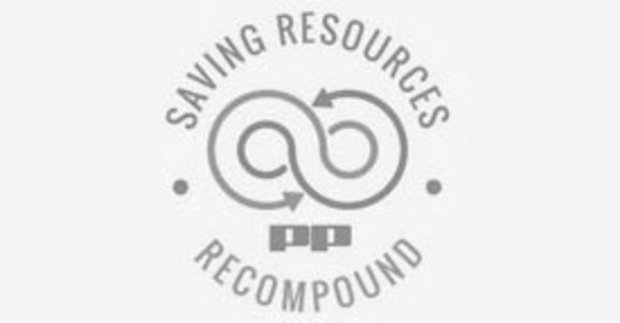We are a specialist in environmentally friendly packaging and can support you as a climate-neutral company by offering CO2-neutral versions of all our products for relatively little additional cost. The section below details four ways in which you can use film packaging that is as environmentally friendly as possible and can even act as an effective means of advertising if desired.

If packaging do not need to be food-safe and has a film thickness of > 50 µ, it can be created using films made from high-quality recycled materials. These films differ greatly from lower quality regenerates. This recompound material comprises recycled PE left over from the film extrusion process, which is not only visually similar or identical to new material but also has comparable properties to it. The German Environment Agency (Umweltbundesamt) recommends this solution as it offers the best eco-balance.
We does not charge extra for this material. Depending on the market situation, you may even benefit from a price saving.
A logo can be printed on the film on request to enable you to show customers your commitment to the environment.

With this option you keep using your ‘normal’ PE film based on fossil raw materials. To offset the environmental impact, we make payments to a climate protection project of your choice (Scope 1+2). We offer you several such projects to choose from and you will receive an original certificate from your chosen project. We are a carbon-neutral company and can supply you with all products in climate-neutral versions on request (Scope 1-3).
From a certain order quantity, a logo can be printed on the film to show customers your commitment to the environment. Alternatively, we can also supply stickers.
This option will increase your packaging costs by a maximum of 2%. A small amount, but with big positives for the environment.

If you need biobased LDPE, we use ‘OK biobased’ with a four-star rating. This is made using sugar cane and has a certified minimum biobased content of 80% (100% is not yet technically possible). It uses a waste product that is generated anyway when harvesting sugar cane. No additional arable land is required. The film is indistinguishable from fossil-based LDPE and can be recycled with this in the normal cycle.
This film can naturally also be printed with a logo.
Depending on the market situation, this option incurs additional costs of approx. 50%.
4. Compostable
More often requested by customers, but in our opinion the least expedient option, is the use of compostable filmmade from corn or potato starch. The mere fact that such film is only compostable in industrial composting plants and will most likely never arrive at such places when disposed of casts doubt on how much sense this material actually makes. Information about the problems associated with these plastics can be found on the German Environment Agency’s website at: www.umweltbundesamt.de/themen/tueten-aus-bioplastik-sind-keine-alternative.
Despite the above, we can naturally still offer you this version and – as is particularly expedient here – print on it accordingly.
Depending on the market situation, this option incurs additional costs of approx. 350%.
In our opinion, the combination of recompound material - if applicable - and certified climate
neutrality makes the most sense from both a marketing and an environmental point of view.
You can highlight both in an effective advertising way with an imprint.
Interesting facts about climate neutrality (Source: abridged from https://www.climatepartner.com/de/wissen/insights/scope-emissionen-reduzieren; own emphases)
“The international community has long recognized that greenhouse gas emissions must be reduced worldwide in order to stop global warming. With the Kyoto Protocol of 1997, countries agreed for the first time in history on binding targets and measures to combat climate change. This agreement formed the basis for the Greenhouse Gas (GHG) Protocol. The GHG Protocol was developed in 1998 on the joint initiative of the World Resources Institute and the World Business Council for Sustainable Development in order to create a uniform framework for calculating greenhouse gases. ... It includes guidelines and specifications that enable companies to take stock of their greenhouse gas emissions and calculate their corporate carbon footprint.
The Corporate Carbon Footprint (CCF) describes the total amount of greenhouse gas emissions (including CO₂ emissions) generated directly or indirectly by a company's business activities. ... The GHG Protocol Corporate Standard categorizes greenhouse gas emissions associated with a company's corporate carbon footprint as Scope 1, 2 and 3 emissions. ... According to the GHG Protocol, the main purpose of this categorization is to distinguish sources of direct and indirect emissions and to ensure that two or more companies do not report emissions in the same scope. ...
However, these scopes do not concern the Product Carbon Footprint (PCF), which describes the total amount of greenhouse gas emissions caused by a product or service over various phases of its life cycle. ...
The GHG Protocol requires all Scope 1 and 2 emissions to be accounted for. ...
1. scope 1 - direct emissions
Scope 1 emissions are emissions from sources for which companies are directly responsible or controlled. This includes emissions from energy sources at the company's site, such as natural gas and fuels, coolants, as well as emissions from the operation of boilers and furnaces. ... Scope 1 also includes emissions from the company's own vehicle fleet (e.g. cars, vans, trucks, ... etc.).
In contrast to direct emissions, the GHG Protocol defines indirect emissions as the result of a company's operations, but from sources owned or controlled by another company. These include the . Scope 2 and 3 emissions. …
2 Scope 2 - indirect emissions from purchased energy
Scope 2 emissions are indirect greenhouse gas emissions from purchased energy, such as electricity, steam, district heating ... that is generated outside the company's own system boundaries but consumed by it. ... If companies themselves generate energy from sources that they are responsible for or control [e.g. photovoltaics at Poly-Pack], the associated emissions are considered direct Scope 1 emissions. ...
3. scope 3 - indirect emissions within the value chain
Scope 3 includes all indirect emissions that occur along the value chain of companies. To make a clear distinction between Scope 2 and Scope 3, the US Environmental Protection Agency (EPA) describes Scope 3 emissions as “the result of activities from facilities that are not owned or controlled by your company, but your company directly influences these activities within its own value chain.”
Other products:
- Bags and sacks
- Standard and sepcial requirements
- Special bags
- Shrink and cover hoods
- Flat and blown films
- Blown film sections
- Products made of special film
- Stretch film
- Cardboard packaging and corrugated cardboard products
- Other tapes
- Straps
- Industrial hygiene items
- Masks and face shields
- Devices
- RECOMPOUND
- Product range
